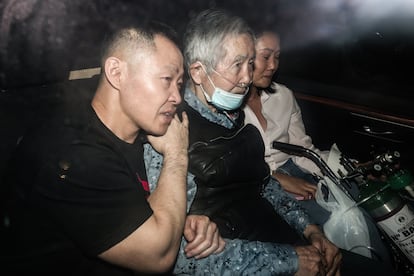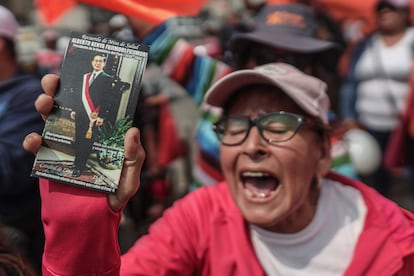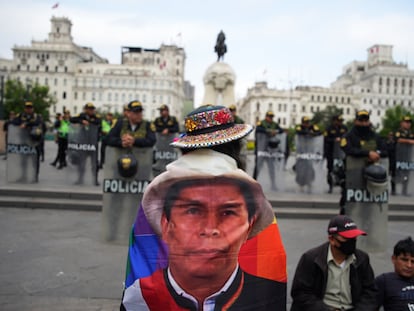Former Peruvian president Alberto Fujimori released from prison
The president of the Inter-American Court of Human Rights had requested Peru not to carry out the order to release the 85-year-old, who was convicted of crimes against humanity

Alberto Fujimori is free. Fourteen years after being sentenced to 25 years in prison, the man who governed Peru in the 1990s left Barbadillo prison in Lima on Wednesday afternoon. He did so in the company of his children Keiko and Kenji, the most political of his clan, amid questions over the legality of his release. The 85-year-old was serving a 25-year sentence for crimes against humanity, but on Tuesday, Peru’s Constitutional Court ordered his immediate humanitarian release — a decision which contravenes an order from the Inter-American Court of Human Rights.
The scene leading up to his release was almost identical to what happened in December 2017, when he was pardoned on Christmas Eve. In that instance, he was admitted to a clinic, where he remained for almost 100 days. He had to return to prison after the ruling was revoked.
Hours before his departure on Wednesday, his supporters began gathering outside Barbadillo. Eleven children in school uniforms arrived with a group of women. They stood in front of the prison and held a banner with the face of Alberto Fujimori and the word “welcome” — a message that is an affront to the victims of the Fujimori regime. The students were no older than 12: when they were born, Fujimori had already been behind bars for a handful of years. “Their parents are Fujimori supporters, and they have given them permission,” a woman accompanying them responded curtly.
At 1 p.m., the countdown was on for the release of the former Peruvian-Japanese president, who established a dictatorship in the 1990s. A hundred of his supporters turned the exit from the Barbadillo prison into a rally. Fujimori’s face was everywhere: on banners, flags, poles and even on beer cans. “Who saved us from terror? El Chino did it,” read a billboard posted on an adjacent wall, in reference to Fujimori, who is often called “El Chino” or “the Chinese man” in Peru, despite having Japanese — not Chinese — roots.

Meanwhile, two speakers played on loop El ritmo del Chino, a technocumbia that Fujimori used during his re-election campaign in the 2000s before his corruption scandals were uncovered. Only 30 police officers were guarding the exit to the prison. Every time a car entered or left the facility, his supporters and the press rushed to find out who it was.
“Brave Chino, here are your people,” the supporters chanted to Fujimori, who resigned by fax from Japan. The woman holding the megaphone was Nikita Ríos. “No one is paying me. I am a grateful supporter. The country was bleeding, and he brought peace,” she said.
Later in the afternoon, Flor de los Milagros Contreras León, a member of La Resistencia, the shock force of Fujimorism, took the floor to criticize the Inter-American Court of Human Rights: “The best president of Peru is kidnapped for defending Peru. It’s all the fault of the miserable terrorists-defending court. But no more injustice. Fujimori will be free.”
On Tuesday, the president of the Inter-American Court of Human Rights, Ricardo Pérez Manrique, ordered Peru to refrain from executing the release of Fujimori, just as it did in March 2022. However, bypassing the supranational justice body, Peru’s Constitutional Court ordered that habeas corpus be made effective and, with it, the humanitarian pardon granted to Fujimori six years ago by then-president Pedro Pablo Kuczynski.
Judge Manuel Monteagudo, one of the members of Constitutional Court, said the ruling was made irregularly. He argued the order was not on the court’s agenda and was approved behind his back. “A second order was issued of which the rest of the magistrates, that is, those of us who voted against it, were not aware,” he said.
By 2 p.m. on Wednesday, Fujimori’s supporters were beginning to get impatient and began calling on the National Penitentiary Institute (INPE) to release him. “If you don’t, it means you have him captured. Do it, or we will be the mockery of the well-to-do leftists,” said one supporter.
Tensions eased when it was learned that Keiko Fujimori and her brother Kenji had left their home in San Borja, and were heading to the prison. It was the sign that they were waiting for. Shortly after 3p.m., Fujimori’s children drove into the prison, with Keiko at the wheel. The car drove in slowly, as if in a procession, as it was swarmed by journalists and supporters. The moment was near.
Sign up for our weekly newsletter to get more English-language news coverage from EL PAÍS USA Edition
Tu suscripción se está usando en otro dispositivo
¿Quieres añadir otro usuario a tu suscripción?
Si continúas leyendo en este dispositivo, no se podrá leer en el otro.
FlechaTu suscripción se está usando en otro dispositivo y solo puedes acceder a EL PAÍS desde un dispositivo a la vez.
Si quieres compartir tu cuenta, cambia tu suscripción a la modalidad Premium, así podrás añadir otro usuario. Cada uno accederá con su propia cuenta de email, lo que os permitirá personalizar vuestra experiencia en EL PAÍS.
¿Tienes una suscripción de empresa? Accede aquí para contratar más cuentas.
En el caso de no saber quién está usando tu cuenta, te recomendamos cambiar tu contraseña aquí.
Si decides continuar compartiendo tu cuenta, este mensaje se mostrará en tu dispositivo y en el de la otra persona que está usando tu cuenta de forma indefinida, afectando a tu experiencia de lectura. Puedes consultar aquí los términos y condiciones de la suscripción digital.
More information
Archived In
Últimas noticias
The complicated life of Francesca Albanese: A rising figure in Italy but barred from every bank by Trump’s sanctions
How Japan is trying to avert ‘digital defeat’
Reinhard Genzel, Nobel laureate in physics: ‘One-minute videos will never give you the truth’
Pinochet’s victims grapple with José Antonio Kast’s rise in Chile
Most viewed
- Pablo Escobar’s hippos: A serious environmental problem, 40 years on
- Why we lost the habit of sleeping in two segments and how that changed our sense of time
- Trump’s obsession with putting his name on everything is unprecedented in the United States
- The Florida Keys tourist paradise is besieged by immigration agents: ‘We’ve never seen anything like this’
- Charles Dubouloz, mountaineering star, retires at 36 with a farewell tour inspired by Walter Bonatti











































